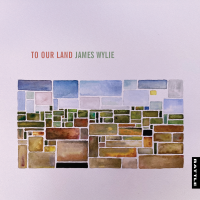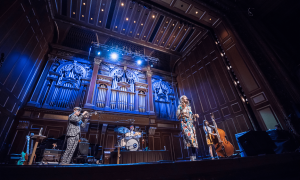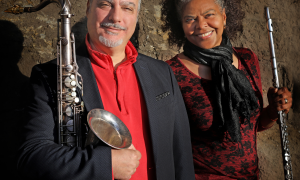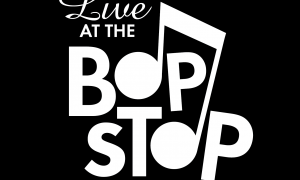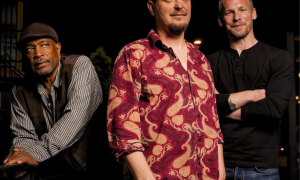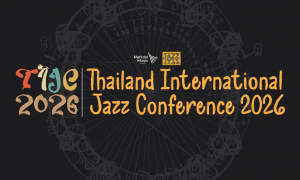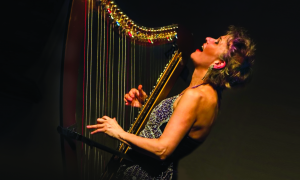
Letter of Interest Deadline
Friday, February 3, 2012 at 5:00 p.m.
Invited Full Proposal Deadline
March 2, 2012 at 5:00 p.m.
The Jazz Arts Group (JAG) in Columbus, Ohio has been awarded funding from the Doris Duke Charitable Foundation to conduct programming and marketing experiments based on results of the Jazz Audiences Initiative (JAI) study, released in October 2011. JAG is looking for three organizations to participate in theory-to-practice experiments linked to the study's key findings.
Background
The JAI, launched in November 2009, was designed to study fundamental questions about how and why people engage with jazz. Funded initially in large part by a $200,000 grant from the Doris Duke Charitable Foundation, the main goal was to learn new ways for engaging audiences, and infusing the art form with new energy. JAI serves as a catalyst to:
1) Collect and analyze attitudes and behaviors of jazz ticket buyers across the U.S.
2) Examine music preferences and concert-attendance trends in central Ohio.
3) Combat the idea that jazz is dying or that there is too much supply.
4) Generate ideas for meaningful involvement opportunities (programs, venues) that speak to a larger, younger constituency, and eliminate barriers to participation
5) Develop and test the persuasiveness of new messages/language designed to motivate current and potential jazz audiences.
6) Create a learning community for jazz professionals.
Alan Brown, Rebecca Ratzkin, and Jennifer Novak-Leonard of WolfBrown conducted the JAI research. Data was collected from research partners that included Jazz Arts Group, Jazz at Lincoln Center, SFJazz, Monterey Jazz Festival, Jazz St. Louis, Scullers Jazz Club (Boston) and a consortium of 13 major university presenters.
Overview of JAI Key Findings
JAI is the first-of-its-kind, comprehensive study for the field of jazz. Key findings include:
Musical tastes are socially transmitted.
Jazz has a relatively diverse audience.
The artist drives ticket-buying decisions.
Local programming shapes audience preferences.
Young listeners are eclectic in their tastes and refuse to be categorized.
There are many pathways into jazz.
Jazz listeners prefer informal settings.
During a national convening held in August 2011, key leaders in the jazz field identified five priority areas. For the purposes of these experiments, we have chosen to focus on the top two priorities—(1) the field must explore new and effective ways to present jazz in more intimate spaces, and (2) audience engagement practices must improve to increase tickets sales and contributions. Complete reports and more information can be found at www.jazzartsgroup.org/jai
Requirements and Characteristics of Potential Partners
Throughout 2012 and early 2013, JAG is planning to work closely with at least three organizations who are presenters/producers of jazz events in various locations around the United States. Individual artists/musicians are not eligible to apply on their own, but may partner with a presenting/producing organization. Chosen partner organizations must charge for programming (admission or ticket sales) and demonstrate a genuine interest in experimenting with ways to sustain presenting and producing in smaller venues; and explore new ways to leverage story, context, and messaging for deeper audience engagement.
Prospective partners must have a deep desire to experiment with ways to put the theory into practice, and collect data, for the benefit of their organization and the wider jazz field. Interested organizations must make clear linkages to the JAI key findings and promising practices identified during the August 2011 JAI convening. (See link below to view research reports.) Partner applicants should align proposed experiments with the following focus areas:
Experiment Focus #1: Ways to Sustain Presenting and Producing in Smaller, More Intimate Venues
The JAI research findings demonstrate that venue preference is a significant decision factor for audiences when deciding whether or not to engage with jazz. Across almost all market segments, current and potential ticket buyers indicated they would most likely prefer to engage with jazz in clubs or lounges with small tables, especially buyers who are 18-34 years old. These findings lead us to explore the following questions:
1) What is the new sustainable business model for presenting in small or unusual venues?
2) What kinds of partnerships can be created between traditional jazz presenters and producers who program large halls, and smaller, even commercial venues?
3) Is the venue more important than the artist?
4) What factors make a venue feel intimate?
5) In what ways can existing spaces be adapted to feel more intimate?
6) What is the artist's role in creating an intimate performance?
7) What will the next generation jazz space look like?
8) In what ways can the data about venue preference inform the requirements of hall rental agreements?
Experimentation, dialogue, and assessment among the identified partners will allow us to scale findings for organizations of all sizes and locales.
Experiment Focus #2: Ways to Leverage Story, Context, and Messaging for Deeper Audience Engagement
JAI research findings demonstrate the need to improve engagement for audiences. Full implementation and impact of this research will require organizations to design, test, implement and refine messages and images that motivate audiences to action. The research should serve as a guide for experiments about ways to effectively communicate with each market segment (10 in all), and/or across segments simultaneously. One approach may be to focus on similarities between segments when designing programming initiatives and marketing materials. The audience segmentation reports reveal a great diversity of experience and knowledge about jazz among ticket buyers. This finding suggests a need to experiment with different packaging models and different levels of educational and experiential programming for unique segments. For example, organizations might design imaginative educational experiences to provide context and learning for the market segment of “Social Butterflies," who do not know much about jazz, but are interested in learning more. Research for both current and prospective ticket buyers demonstrates high levels of past involvement in music activities. Previous experience with the art form, combined with aspirations to “play a musical instrument again," suggests a need to deploy experiments around ways to leverage the “latent demand" for playing an instrument.
Timeline
February 3, 2012 Deadline for Letter of Interest February 10, 2012 Select organizations notified and invited to submit a full proposal March 2, 2012 Deadline for submission of full proposal March 9, 2012 Partner organizations chosen and notified Week of March 19, 2012 Call with chosen partners to discuss proposed experiments and next steps September 2012—April 2013 Experiments take place with frequent reporting and sharing among partners and interested jazz practitioners
Requirements of Selected Partners
Partners are expected to plan and launch at least one (1) experiment between September 2012 and April 2013. Each selected partner (at least 3) may receive up to $15,000 of Doris Duke Charitable Foundation funds to implement the experiment(s). Once chosen to participate as an experimental partner, organizations are expected to be transparent with
programming strategies, including but not limited to artist selection, ticket prices, marketing strategies, and financial information. This transparency will allow all partners to fully evaluate and learn from the unique experiments. Each partner will be expected to keep a detailed account/journal of the decisions made during the experiment and why. Partners are expected to participate in a Community of Practice (CoP) leading up to and throughout the duration of the experiments. We intend to use a diffusion strategy to share learning with the field. Partners will convene online at periodic intervals from March 2012 through the last experiments in the spring of 2013. If possible, we will facilitate a working group meeting during the JEN and/or APAP conferences in January 2013. Lessons learned from experiments will be collected and assembled to create a “portfolio of learning," linked to measurable outcomes to be identified with a professional consultant after partners are identified.
Potential outcomes include (1) engagement of new and/or younger audiences, (2) employing local/regional jazz artists, (3) creating a “bank" of language and images for each market segment, and (4) pilot testing a new business model for making smaller-scale programming sustainable.
All data will inform the new business model for presenting in smaller, unusual spaces.
Letter of Intent Format (Deadline is Friday, February 3, 2012 at 5:00 p.m.)
Please submit a one-page Letter of Interest stating your organization's interest in working with the Jazz Arts Group to design and launch a theory-to-practice experiment(s) clearly linked to JAI data. Provide brief answers to the following questions:
1) Why are you interested in participating as a partner in this initiative? What do you hope to learn?
2) In what ways do you think your experiment(s) will change your organizational practice(s)?
3) Describe your proposed experiment(s).
4) Which JAI key findings or promising practices are you planning to use as the basis for your experiments and learning?
5) What kind of input/coaching would you find most helpful from fellow partners and/or peers in the jazz field?
Include one brief paragraph outlining the potential project budget. Discuss your requirements for project funding of up to $15,000, and the total anticipated earned or unearned revenue as a result of the experiment(s). Include any matching/additional funds you plan to allocate toward your experiment(s). Priority will be given to organizations that commit up to $5,000 of additional financial resources toward the experiment(s).
To review the 2011 JAI Convening Report with Key Findings and Promising Practices, and/or the full research reports, go here.
Friday, February 3, 2012 at 5:00 p.m.
Invited Full Proposal Deadline
March 2, 2012 at 5:00 p.m.
The Jazz Arts Group (JAG) in Columbus, Ohio has been awarded funding from the Doris Duke Charitable Foundation to conduct programming and marketing experiments based on results of the Jazz Audiences Initiative (JAI) study, released in October 2011. JAG is looking for three organizations to participate in theory-to-practice experiments linked to the study's key findings.
Background
The JAI, launched in November 2009, was designed to study fundamental questions about how and why people engage with jazz. Funded initially in large part by a $200,000 grant from the Doris Duke Charitable Foundation, the main goal was to learn new ways for engaging audiences, and infusing the art form with new energy. JAI serves as a catalyst to:
1) Collect and analyze attitudes and behaviors of jazz ticket buyers across the U.S.
2) Examine music preferences and concert-attendance trends in central Ohio.
3) Combat the idea that jazz is dying or that there is too much supply.
4) Generate ideas for meaningful involvement opportunities (programs, venues) that speak to a larger, younger constituency, and eliminate barriers to participation
5) Develop and test the persuasiveness of new messages/language designed to motivate current and potential jazz audiences.
6) Create a learning community for jazz professionals.
Alan Brown, Rebecca Ratzkin, and Jennifer Novak-Leonard of WolfBrown conducted the JAI research. Data was collected from research partners that included Jazz Arts Group, Jazz at Lincoln Center, SFJazz, Monterey Jazz Festival, Jazz St. Louis, Scullers Jazz Club (Boston) and a consortium of 13 major university presenters.
Overview of JAI Key Findings
JAI is the first-of-its-kind, comprehensive study for the field of jazz. Key findings include:
Musical tastes are socially transmitted.
Jazz has a relatively diverse audience.
The artist drives ticket-buying decisions.
Local programming shapes audience preferences.
Young listeners are eclectic in their tastes and refuse to be categorized.
There are many pathways into jazz.
Jazz listeners prefer informal settings.
During a national convening held in August 2011, key leaders in the jazz field identified five priority areas. For the purposes of these experiments, we have chosen to focus on the top two priorities—(1) the field must explore new and effective ways to present jazz in more intimate spaces, and (2) audience engagement practices must improve to increase tickets sales and contributions. Complete reports and more information can be found at www.jazzartsgroup.org/jai
Requirements and Characteristics of Potential Partners
Throughout 2012 and early 2013, JAG is planning to work closely with at least three organizations who are presenters/producers of jazz events in various locations around the United States. Individual artists/musicians are not eligible to apply on their own, but may partner with a presenting/producing organization. Chosen partner organizations must charge for programming (admission or ticket sales) and demonstrate a genuine interest in experimenting with ways to sustain presenting and producing in smaller venues; and explore new ways to leverage story, context, and messaging for deeper audience engagement.
Prospective partners must have a deep desire to experiment with ways to put the theory into practice, and collect data, for the benefit of their organization and the wider jazz field. Interested organizations must make clear linkages to the JAI key findings and promising practices identified during the August 2011 JAI convening. (See link below to view research reports.) Partner applicants should align proposed experiments with the following focus areas:
Experiment Focus #1: Ways to Sustain Presenting and Producing in Smaller, More Intimate Venues
The JAI research findings demonstrate that venue preference is a significant decision factor for audiences when deciding whether or not to engage with jazz. Across almost all market segments, current and potential ticket buyers indicated they would most likely prefer to engage with jazz in clubs or lounges with small tables, especially buyers who are 18-34 years old. These findings lead us to explore the following questions:
1) What is the new sustainable business model for presenting in small or unusual venues?
2) What kinds of partnerships can be created between traditional jazz presenters and producers who program large halls, and smaller, even commercial venues?
3) Is the venue more important than the artist?
4) What factors make a venue feel intimate?
5) In what ways can existing spaces be adapted to feel more intimate?
6) What is the artist's role in creating an intimate performance?
7) What will the next generation jazz space look like?
8) In what ways can the data about venue preference inform the requirements of hall rental agreements?
Experimentation, dialogue, and assessment among the identified partners will allow us to scale findings for organizations of all sizes and locales.
Experiment Focus #2: Ways to Leverage Story, Context, and Messaging for Deeper Audience Engagement
JAI research findings demonstrate the need to improve engagement for audiences. Full implementation and impact of this research will require organizations to design, test, implement and refine messages and images that motivate audiences to action. The research should serve as a guide for experiments about ways to effectively communicate with each market segment (10 in all), and/or across segments simultaneously. One approach may be to focus on similarities between segments when designing programming initiatives and marketing materials. The audience segmentation reports reveal a great diversity of experience and knowledge about jazz among ticket buyers. This finding suggests a need to experiment with different packaging models and different levels of educational and experiential programming for unique segments. For example, organizations might design imaginative educational experiences to provide context and learning for the market segment of “Social Butterflies," who do not know much about jazz, but are interested in learning more. Research for both current and prospective ticket buyers demonstrates high levels of past involvement in music activities. Previous experience with the art form, combined with aspirations to “play a musical instrument again," suggests a need to deploy experiments around ways to leverage the “latent demand" for playing an instrument.
Timeline
February 3, 2012 Deadline for Letter of Interest February 10, 2012 Select organizations notified and invited to submit a full proposal March 2, 2012 Deadline for submission of full proposal March 9, 2012 Partner organizations chosen and notified Week of March 19, 2012 Call with chosen partners to discuss proposed experiments and next steps September 2012—April 2013 Experiments take place with frequent reporting and sharing among partners and interested jazz practitioners
Requirements of Selected Partners
Partners are expected to plan and launch at least one (1) experiment between September 2012 and April 2013. Each selected partner (at least 3) may receive up to $15,000 of Doris Duke Charitable Foundation funds to implement the experiment(s). Once chosen to participate as an experimental partner, organizations are expected to be transparent with
programming strategies, including but not limited to artist selection, ticket prices, marketing strategies, and financial information. This transparency will allow all partners to fully evaluate and learn from the unique experiments. Each partner will be expected to keep a detailed account/journal of the decisions made during the experiment and why. Partners are expected to participate in a Community of Practice (CoP) leading up to and throughout the duration of the experiments. We intend to use a diffusion strategy to share learning with the field. Partners will convene online at periodic intervals from March 2012 through the last experiments in the spring of 2013. If possible, we will facilitate a working group meeting during the JEN and/or APAP conferences in January 2013. Lessons learned from experiments will be collected and assembled to create a “portfolio of learning," linked to measurable outcomes to be identified with a professional consultant after partners are identified.
Potential outcomes include (1) engagement of new and/or younger audiences, (2) employing local/regional jazz artists, (3) creating a “bank" of language and images for each market segment, and (4) pilot testing a new business model for making smaller-scale programming sustainable.
All data will inform the new business model for presenting in smaller, unusual spaces.
Letter of Intent Format (Deadline is Friday, February 3, 2012 at 5:00 p.m.)
Please submit a one-page Letter of Interest stating your organization's interest in working with the Jazz Arts Group to design and launch a theory-to-practice experiment(s) clearly linked to JAI data. Provide brief answers to the following questions:
1) Why are you interested in participating as a partner in this initiative? What do you hope to learn?
2) In what ways do you think your experiment(s) will change your organizational practice(s)?
3) Describe your proposed experiment(s).
4) Which JAI key findings or promising practices are you planning to use as the basis for your experiments and learning?
5) What kind of input/coaching would you find most helpful from fellow partners and/or peers in the jazz field?
Include one brief paragraph outlining the potential project budget. Discuss your requirements for project funding of up to $15,000, and the total anticipated earned or unearned revenue as a result of the experiment(s). Include any matching/additional funds you plan to allocate toward your experiment(s). Priority will be given to organizations that commit up to $5,000 of additional financial resources toward the experiment(s).
To review the 2011 JAI Convening Report with Key Findings and Promising Practices, and/or the full research reports, go here.







